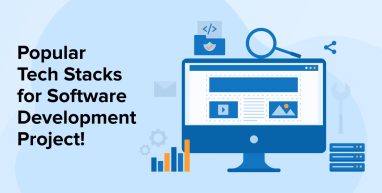
Tech stack is the need of the hour for all businesses. To make a fully functional and high-performing steady application, one must have knowledge of popular tech stacks used in the development process of their apps. A tech stack is a data ecosystem with a collection of different tools, technologies, and programming languages that developers use to create a custom application either for mobile platforms or the web.
So, this can be a curious question: how does a tech stack work? How is the decision made on the technologies being used in app development? It’s time to explore and discover how these popular tech stacks work and how significantly they can make or break your software application. So let’s start from scratch.
1. What is a Tech Stack?
The technology stack or tech stack is one of the inevitable tools for any software development project. To define a tech stack, it is a collection of tools and programming languages that work together to create digital products like mobile apps, web apps, web frameworks, and websites. A technology stack can be considered as an ecosystem of data, programs, and tools that can be used to create custom apps or specific software or products.
There are various popular tech stacks available to handle different tasks associated with web application development and operations. Also, software development services have the ability to bring advanced tech stack to build custom business applications.
2. Tech Stack Components
A variety of technologies can be easily made a part of the tech stack. However, it is important to keep in mind that the technology stack will change according to the software development trends. Tech stacks consist of two equally important components which are a part of the technology stack. It is categorized as frontend i.e.- client-facing tech stack and the backend i.e. server-side tech stack. Both these components work together to form a functional tech stack. The nature of the product development stacks determines the role of developers.
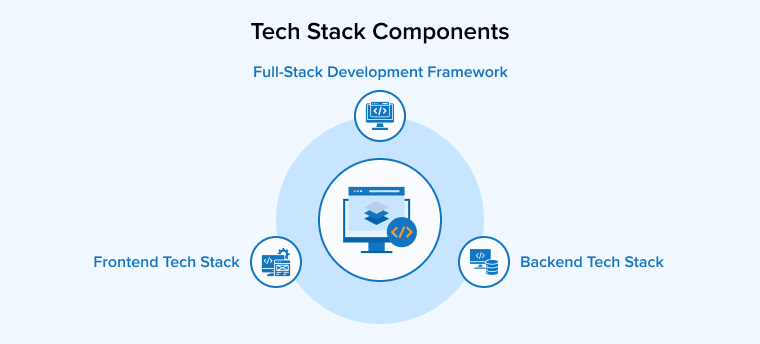
Now, it’s time for us to see what these categorized components look like. Let’s see.
2.1 Frontend Tech Stack
- The content that users see on their screens is referred to as the client-facing or front-end tech stack component. The primary goal of the front end is to provide the user with a hassle-free and seamless user experience. Also, in the frontend framework, there are sub-parts that play an important role. The frontend stack is made up of three major components: HTML (HyperText Markup Language), CSS (Cascading Style Sheets) and JavaScript. HTML is a markup language that is needed to outline web pages.
- CSS is in charge of the style and layout of web pages. JavaScript can be used to make web pages interactive and since it is an Open Web Platform, anyone can use this programming language. There are options for front-end development that are typically limited to JavaScript frameworks.
Popular front-end JavaScript frameworks include Vue.js, Angular, and React.
2.2 Backend Tech Stack
The server side of application development is backend development. It includes the software’s internal structure that is not visible to the user and is responsible for the software’s operation.
The backend technology stack consists of some of the major components such as:
- Programming language: When you decide to create a website, custom logic is created for apps and websites using programming languages. These codes are also associated with a database using the internet. Programming languages have some popular names like JavaScript, PHP, and Python as their few examples.
- Frameworks:They support the development of programmes that use a single programming language. Among the well-known frameworks are Laravel, Django, and Ruby on Rails. Nowadays, MVC-style frameworks are used to create the majority of apps.
- Web servers: Web servers are an essential part when it comes to handling client requests on backend servers. The most popular web servers are Microsoft’s Internet Information Server (IIS), Nginx, and Apache.
- Databases: Most of the applications are using relational and non-relational databases. MySQL and PostgreSQL are relational databases while MongoDB is a Non-Relational database.
2.3 Full-Stack Development Framework
This third category often remains undiscussed because most businesses think it’s either the front end or the back end. But full-stack developers can develop both. Now, who is a Full-stack developer, one who is in charge of making backend servers work seamlessly, and the underlying platform, the user interface, and all other components required for a functional website.
Among the most popular full-stack frameworks are: Python, Django, and Vue.js
3. Top Tech Stack Models
In 2022, most web development technology stacks are still revolving around frameworks utilizing Javascript’s front end. Developers are looking ahead of existing options to see how the latest technologies can assist them in developing better applications. However, choosing an applicable one from these popular tech stacks for different kinds of software projects is very challenging. There are different tech stack models and we will be seeing it in depth to understand which one will suit each business logic.
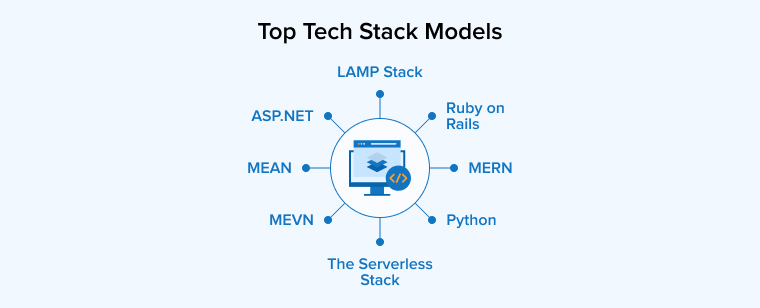
3.1 LAMP Stack
One of the oldest and standard names in tech stack models is the Lamp stack model. This tried and tested method encompasses web development stacks such as Linux (operating system), Apache (HTTP server), MySQL (relational database management), and PHP (programming language, it can also be Perl or Python).
The lamp stack has many layers and all these stack layers are open source and thus free to use. As this tech stack can freely run on all types of operating systems, you can swap out other components within the stack. It is very cost-efficient and can run efficiently across multiple operating systems. The Lampstack is one of the most trending technology stacks because popular open-source CMS such as Drupal and WordPress are using this. Easy to use and sustainable market-driven results have made the LAMP stack an autonomous choice among the developer community to deliver web applications.
So if you want to use LAMP for Microsoft Windows, you can use it as WAMP, and for macOS, use MAMP.
3.2 ASP.NET
ASP.NET is the name that every developer would know. In recent years, Microsoft’s .NET Core has grown in popularity. Modern ASP.NET applications are extremely light and can run on both Windows and Linux. There are many Microsoft technologies that have psyched the developers to work with all its new edge technologies. With NET 5, you don’t have to worry about deciding between .NET Framework and .NET Core.
The following application tech stack is commonly used in .NET applications:
- ASP.NET MVC is a model-view-controller (MVC) framework.
- As a part of tech stack, it utilizes Microsoft’s web server, IIS.
- TypeScript frontend framework for Angular.
- SQL Server is the enterprise database from Microsoft.
- Microsoft Azure is a popular choice among .NET developers.
NGINX and open-source databases such as Postgresql or Mysql are used to run NET applications on Linux.
3.3 MEAN
MEAN, is one of the most popular tech stacks. As MEAN is an end-to-end JavaScript stack, it can use a single language across the application and can stick to it for the future as well. There are other ways too for developers to utilize codes. They can easily reuse codes across entire applications, decreasing the use of codes for reinventing any new application. This is an open-source software stack that can be used by anyone and also has a wide community of developers to support the development needs.
It offers numerous advantages to web developers. The advantages probe the utilization of a single language like JavaScript and other underlying technologies that are also open source and free.
Like MEAN consists of typically 4 major aspects of the development stack:
- MongoDB (NoSQL database).
- Express.js is a backend web framework.
- Angular.js as a Front-end framework.
- Node.js server-side.
JavaScript MEAN is a practical approach to developing fast and highly efficient apps. For data transmission and free module library access, all of the components use JSON. This tech stack aids in the development of scalable software products. It’s ideal for all types of websites and interactive applications.
3.4 MERN
The MERN is fundamentally similar to MEAN, with the only difference being that React is used instead of Angular. Because 2022 is all about improved UI, the MERN stack stands out from the crowd. The components are as follows:
- MongoDB (database).
- Backend development framework (JS).
- The React library (for developing user interfaces).
- JS built on Chrome’s V8 platform (to handle the server).
When you use MERN, you are simply enabling easy access to React integration, easily coding on servers and browsers at the same time. You will also have full-stack development options like backend and frontend development and also utilization of powerful functional libraries. Furthermore, React is a fantastic library popular for its high performance and flexibility in creating interactive user interfaces.
3.5 MEVN
If you haven’t come across the right tech stack, the MEVN stack is for you. MEVN stack is an alternate version of MEAN, in which Vue.js can easily take up the place of AngularJS as a frontend framework. More technologies can also be included like MongoDB, Express.js, Vue.js, and Node.js which are some of them.
When replaced with Vue.js, it is because Vue is simple to use and offers high performance for web applications. As a result, it has gained popularity in recent years. However, in order to extend the functional use of MEVN, you need third-party services such as Fortune Soft. Vue has a wide variety of features with rich tools and functionalities that can help app developers to create high-performing and resilient applications.
The MEVN stack creates applications that support MVC (Model-View-Controller) and has improved server-side interactivity.
Some famous brands like Facebook and Adobe use the MEVN stack with Vue.js as their development platform.
3.6 Ruby on Rails
In these popular tech stacks, the next one on the list is Ruby on Rails (RoR). It is a framework for creating model-view-controller (MVC) applications. RoR is used by large, monolithic sites such as Basecamp, Shopify, Dribbble, and GitHub.
‘Ruby on Rails’ makes the software development process easier. Ruby on Rails represents software packages and libraries, as well as simpler coding facilities and documentation. RoR is highly scalable and useful in conjunction with MySQL. Ruby allows developers to work more efficiently, spend less time creating products, debug code more easily, and avoid reinventing the wheel with each new project.
3.7 Python
Python is one of the most popular programming languages. It has a lot of advanced and powerful features. Python has also grown in popularity due to its extensive use in machine learning and data science. It can also be used to create web applications by leveraging the well-known Django web framework.
Python appears to be the best language for machine learning, and data analytics. It outperforms in terms of community support and a plethora of intriguing open-source projects. It is a shining light in the world of computer programming for two reasons: it can handle a wide range of tasks and it is a very beginner-friendly language.
3.8 The Serverless Stack
Web stack or technology stack, both of these have been playing an imperative role in web development. This is the right time if you as a business want to make a switch to a Serverless technology stack. To make the understanding more precise, serverless systems are nothing but cloud infrastructures. Infrastructure Management becomes easy when it is on the cloud. You get all the services and tools offered by cloud computing platforms. It is easy to use, efficient and scalable.
4. Conclusion
So the moral for the whole discussion on popular tech stacks for software development is that “one size doesn’t fit all”. Therefore choosing the right tech stack can be a daunting task for every business because your chosen tech stack should enable you to utilise both your human resources as well as technological resources to their fullest potential. A software project can be a nightmare if you don’t choose the right one. So take your time, do your research, compare your options, and choose the best one on the market that meets your specific business needs. Remember that the wrong technology stack can result in an irreversible financial disaster.
And, if you’re unsure about the world of software product development, it’s best to leave it to the pros. Top-tier software development firms can help you choose the best technology stacks on the market. As a result, you can rest assured that your project is in capable hands.


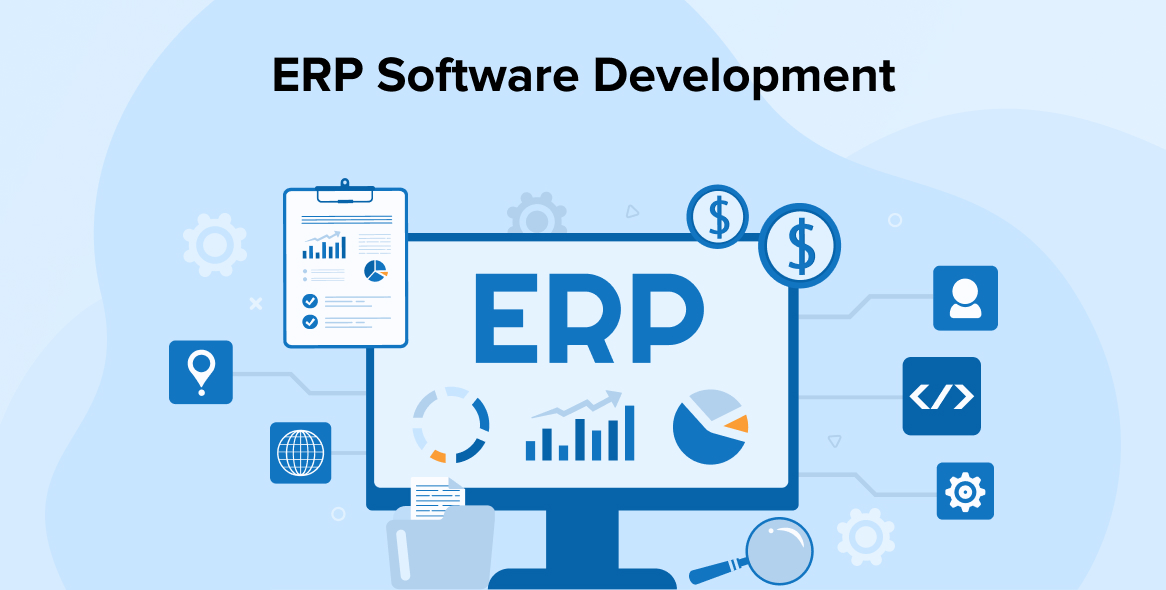
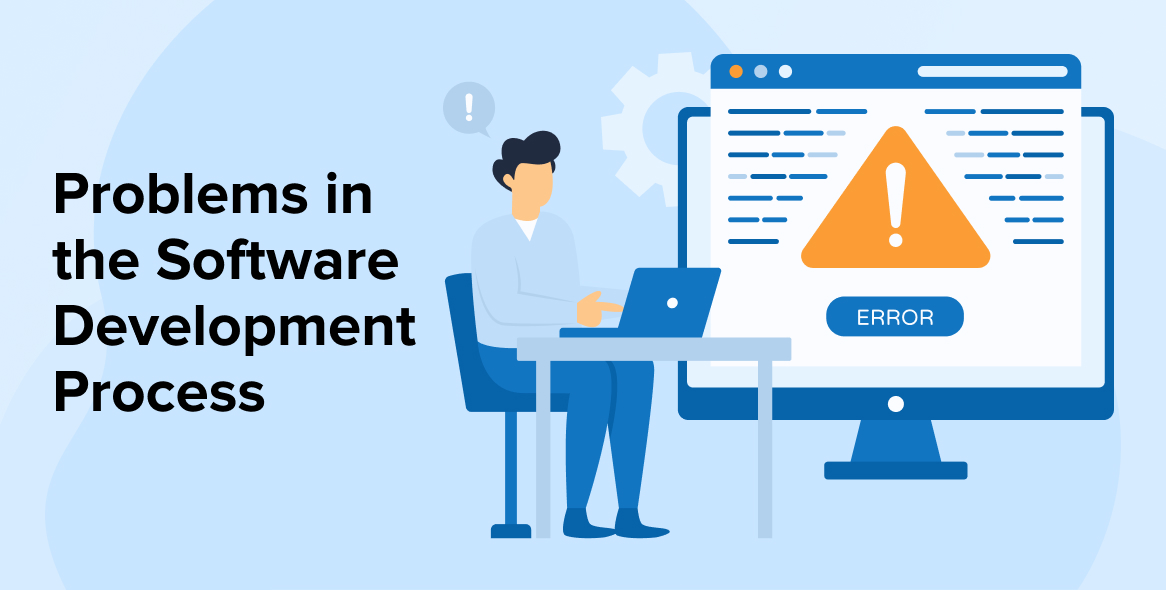


Comments
Leave a message...